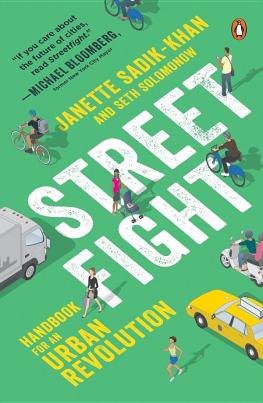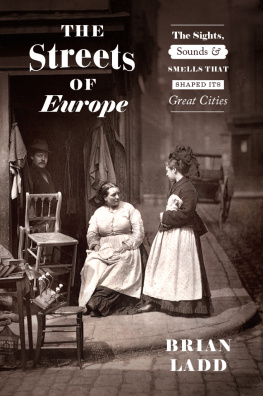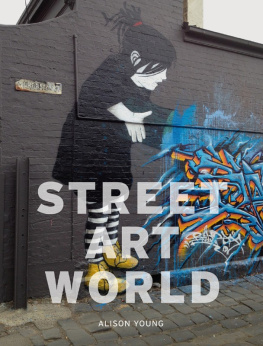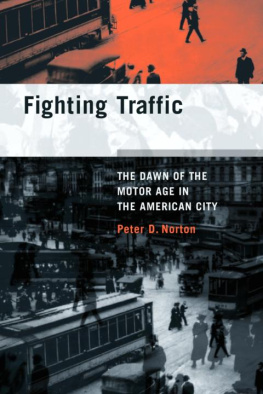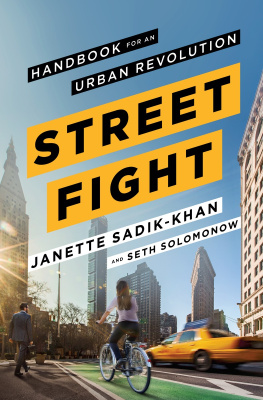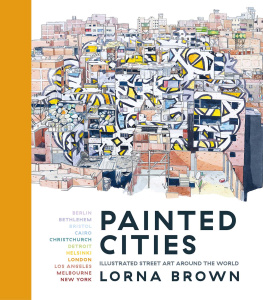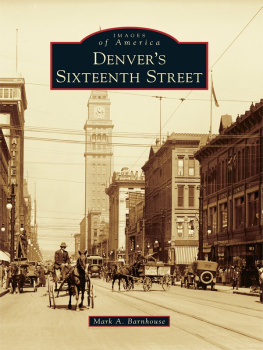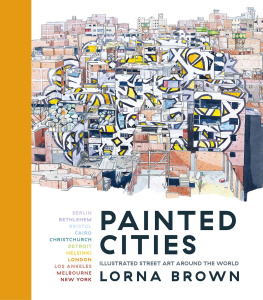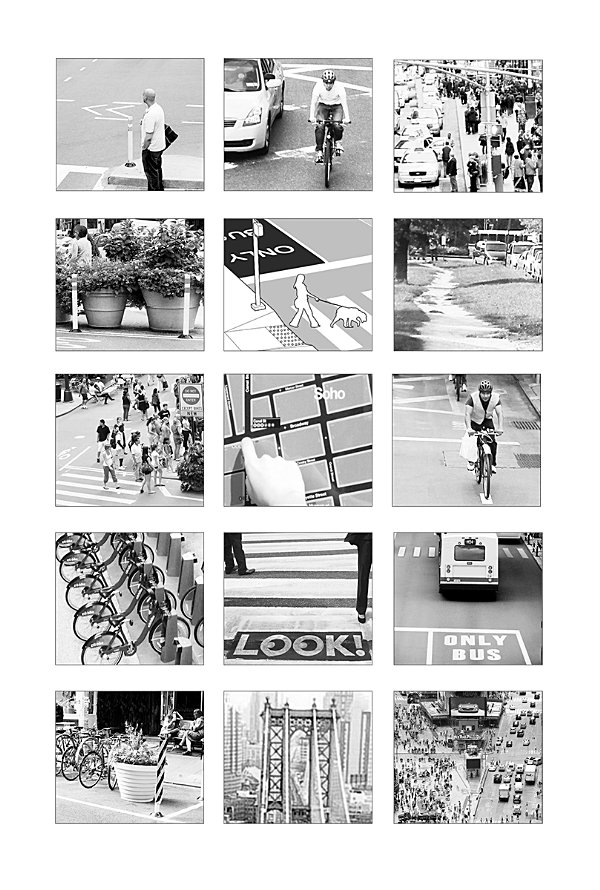Praise for Janette Sadik-Khan and Streetfight
[A] bicycle visionary.
Frank Bruni, The New York Times
Sadik-Khan manages to be equal parts Jane Jacobs and Robert Moses.
New York Magazine
If [Robert] Moses had owned a pink fingernail of [Sadik-Khans] beguilement, he might have scored a bridge across the Atlantic.
Esquire
[Sadik-Khan is] an urban visionary who cuts through the gridlock.
Slate
Janette Sadik-Khan is like the child that Robert Moses and Jane Jacobs never had: an urban visionary determined to reshape the streets of New York, but with an abiding concern for the health of neighborhoods and the safety of their residents. If you care about the future of cities, read Streetfight .
Michael Bloomberg, former New York City mayor
This book is an urban epic as audacious as the changes Janette Sadik-Khan made to the map of New York City. She is a superhero for cities and an inspiration that streets built to human scale arent impossible, but merely awaiting those who dare.
Jan Gehl, urbanist, architect, author
Cities are where innovation, creativity, and the unexpected happens, and Janette has helped make ours, New York City, safer, more livable, and more profitable all at once. I watched these exciting changes happen, but the really interesting part is how she managed to implement these changes quickly and cheaply. Thats where other cities can use this as a manual for change on issues like health reform, education, and the arts. This, then, is not just a book about transportation.
David Byrne, musician, artist
To create safe and inclusive cities, being a visionary is not enough. You must also be an advocate, a communicator, a doer, and, perhaps most importantly, a street fighter. Janette is that person and this is a book that provides the proof of the possible for citizens and their elected leaders everywhere.
Enrique Pealosa, mayor of Bogota
PENGUIN BOOKS
STREETFIGHT
Janette Sadik-Khan is one of the worlds foremost authorities on transportation and urban transformation. She served as New York Citys transportation commissioner from 2007 to 2013 under Mayor Michael Bloomberg, overseeing historic changes to New York Citys streetsclosing Broadway to cars in Times Square, building nearly four hundred miles of bike lanes, and creating more than sixty plazas citywide. A founding principal with Bloomberg Associates, she works with mayors around the world to reimagine and redesign their cities. She chairs the National Association of Transportation Officials, implementing new people-focused street design standards that have been adopted in forty-five cities across the continent. She lives in New York City.
Seth Solomonow is a manager with Bloomberg Associates. He was the chief media strategist for Janette Sadik-Khan and New York Citys transportation department under Mayor Michael Bloomberg. A graduate of Columbia University Graduate School of Journalism, Solomonow has written for The New York Times and his hometown newspaper, The Staten Island Advance . He lives in Brooklyn, New York.
www.jsadikkhan.com
@jsadikkhan
PENGUIN BOOKS
An imprint of Penguin Random House LLC
375 Hudson Street
New York, New York 10014
penguin.com
First published in the United States of America by Viking Penguin, an imprint of Penguin Random House LLC, 2016
Published in Penguin Books 2017
Copyright 2016 by Janette Sadik-Khan and Seth Solomonow
Penguin supports copyright. Copyright fuels creativity, encourages diverse voices, promotes free speech, and creates a vibrant culture. Thank you for buying an authorized edition of this book and for complying with copyright laws by not reproducing, scanning, or distributing any part of it in any form without permission. You are supporting writers and allowing Penguin to continue to publish books for every reader.
Photograph and map illustration credits
Interior : From Urban Street Design Guide by NACTO. Copyright 2013 National Association of City Transportation Officials. Reproduced by permission of Island Press, Washington, DC.
Interior the City of New York. 200514. New York City Department of Transportation. All rights reserved.
Other credits appear in the captions of the respective images.
Ebook ISBN: 9780698409415
Cover design: Evan Gaffney
Cover images: (city background) Merten Snijders/Getty Images; (cyclist) Biederbick & Rumpf/F1 Online/Superstock; (businessman) Massimo Colombo/Getty Images
Version_3
To the men and women
of the
New York City Department of Transportation
Contents
Preface
M y six-year, seven-month, eighteen-day tenure as New York City transportation commissioner began with a meeting at City Hall, at the foot of the Brooklyn Bridge, in early spring 2007.
Why do you want to be traffic commissioner? the 108th mayor of New York City asked me.
It was my first time even in a room with Mayor Michael Bloomberg, the billionaire entrepreneur-turned-mayor, now flanked by six of his deputies, Knights of Camelotstyle at an immense round table. Six years into his administration and two years into his second term, it wasnt clear to me that day who or what he was looking for in a commissioner. And here was his very first question.
His question wasnt a test. Its a common misconception that the commissioners job is limited to managing traffic.
I dont want to be the traffic commissioner, I responded. I want to be transportation commissioner.
Bloomberg said nothing, and no one jumped in to break the tension.
Well, at least I got to meet the mayor, I consoled myself, confident that I had just blown the interview.
Nevertheless, I pushed ahead with my priorities, unsure how theyd be received. I wanted to make New York Citys punch-line buses work better. I wanted to make bike riding a real, safe transportation option on New Yorks mean streets. I wanted to institute a toll for people driving into Manhattan during rush hour, creating the congestion that chokes the city, and use its revenue to make these new public transportation options possible.
These were far from mainstream transportation ideas, but I assumed that Team Camelot must have wanted to hear my pitch or they wouldnt have asked me to the table. Michael Bloombergs reputation globally was for innovation and a by-the-numbers-please approach to governance. This was the mayor who created the 311 system that allows residents to dial one number to obtain virtually any city service. He had banned smoking in bars and trans fats from restaurantstrifles compared with his overseeing dramatic reductions in crime and wresting control over city schools from a notoriously ineffective Board of Education. But at the time I sat in front of him, there was no transportation leg to his legacys table, no initiative, goal, or accomplishment on the scale of his other achievements that addressed the fundamental issues of congestion, danger, mobility, and economic stagnation on New Yorks streets.
So I was direct. I knew how the city worked and I wanted to change its transportation status quo. Fifteen years earlier I finished my tenure as transportation adviser to Mayor David Dinkins, after counseling him on local and regional transportation issuessubways, buses, bridges, transit hubs, airports, and highwayswhich included agencies and authorities and not just the transportation department he controlled. Since then I worked under President Bill Clinton at the Federal Transit Administration, helped run the transit practice at Parsons Brinckerhoff, a major international transportation engineering firm, and was founding president of a subsidiary technology consulting company. Based on my audience with Bloomberg, I assumed that he and his team were not on the hunt for someone to ride out the rest of the term with little change or controversy. They wanted a commissioner who understood government architecture and the elements of transportation, but with a private-sector metabolism that thrived on ideas and innovative approaches to problems.

